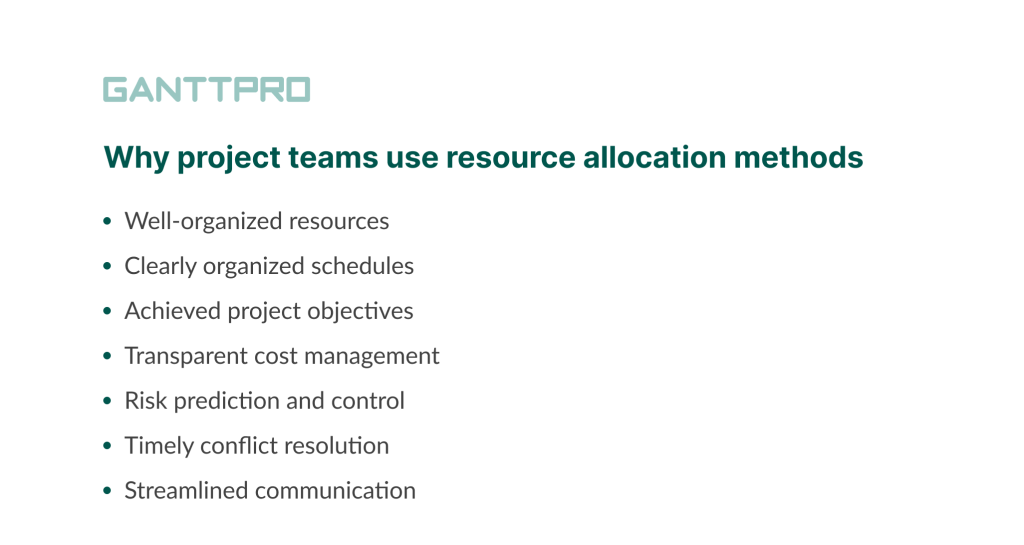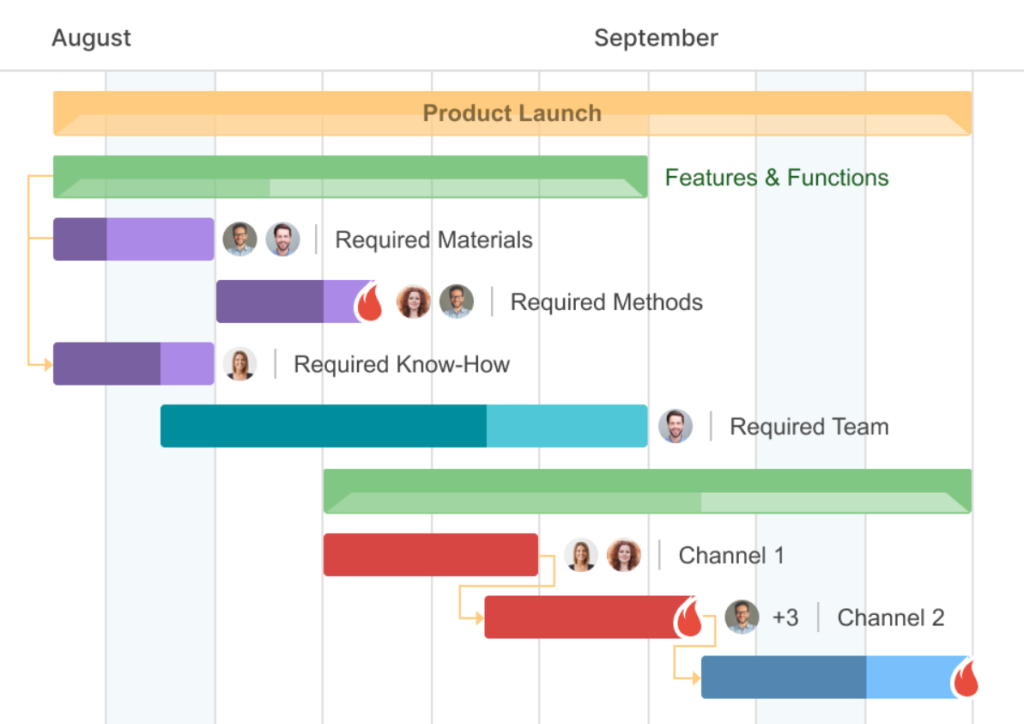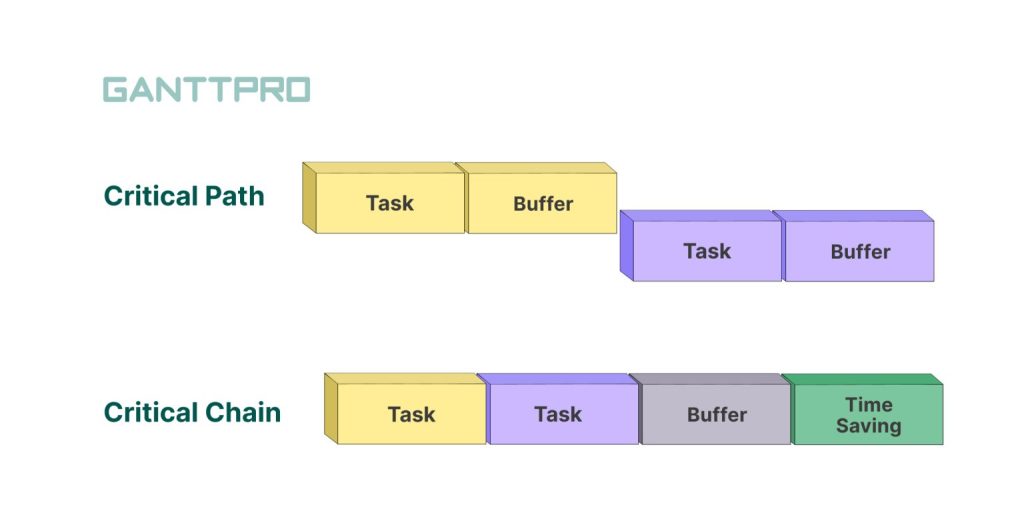8 Tried-and-True Resource Allocation Methods [+Tools to Implement Them]

Audio version:
The process of resource allocation in project management is not a complex science or art understood only by geniuses. It’s more about a simple yet powerful strategy that teaches us how to get the right balance in organizing multiple project assets.
Projects reach better results faster if companies apply appropriate resource allocation methods. Even if managers have a high performing team, plenty of time, and an enviable budget, the lack of a competent approach to effective resource management will probably lead to a project collapse.
However, we won’t focus on collapses at the very beginning of the article, as smart resource allocation methods are reliable ways to improve workflows and benefit any team. In combination with robust resource management software, such methods improve time management, predict risks and possible resource constraints, accelerate team collaboration, and boost stakeholder satisfaction.
If you hesitate how to allocate resources in project management correctly and strive to find proven approaches to this critical process, then dive into the set of core resource allocation methods in project management that we’ve gathered in this article.
Contents:
- How resource allocation methods impact project management.
- Critical path method.
- Critical chain method.
- Resource leveling.
- Resource smoothing.
- Additional resource allocation methods.
How resource allocation methods impact project management
Project owners should keep in mind that resource allocation methods in project management resolve potential resource conflicts and prevent overuse or underuse of assets.
Well-chosen work allocation methods and resource management techniques also reduce work failures, missed deadlines, and project delays. This is the reason to think and reflect, as according to the research made by the PMI (Project Management Institute), 12% of projects were deemed failures by PM professionals. And one of the reasons projects fail is inadequate resources.
Popular methods of resource allocation are crucial for project teams as they help them succeed in many ways.

- Well-organized resources. Professional resource utilization guarantees that finances, time, personnel, equipment, and other resources are utilized optimally. These methods prevent the underutilization or overallocation of work assets. They lead to significant cost savings and empowered productivity.
- Сlearly organized schedules. These approaches are closely tied to work planning and scheduling. They ensure that the right activities are assigned to the right assets within a resource management plan. It logically prevents schedule delays.
- Achieved project objectives. Popular methods of resource allocation in project management assist in meeting project objectives while maintaining quality standards and scope. It ensures the timely availability of necessary assets for project tasks.
- Transparent cost management. By allocating different types of resources in project management based on professional methods, PMs can control and monitor budget issues more effectively. It helps them stay within the cost limits.
- Risk prediction and control. Resource allocation methods in project management allow for identifying potential bottlenecks or resource constraints during the early stages of the project lifecycle. It enables managers to proactively control risks and make adjustments to avoid cost overruns.
- Timely conflict resolution. An effective resource calendar helps minimize conflicts among workers or departments competing for the same resources. The methods applied for this purpose provide a clear allocation plan, which reduces the chances of disputes.
- Streamlined communication. Smart resource allocation methods provide transparency to stakeholders, including team members, clients, and sponsors. It fosters trust and smooth communication.
So, what are these methods that make the job of project managers easier and bring so many benefits to planning and organizing resources?
Most popular resource allocation methods for winning project management
In theory, resource allocation looks straightforward.
It seems that even a project manager without experience can easily break down a project into manageable tasks, involve necessary resources to execute each activity, and lead a project to a finish line. In practice, however, things rarely go exactly according to your plan.
Workers can often split their time between multiple projects, some colleagues often take sick days, and many tasks take longer to complete than expected. These are just a few threats that may await your project.
It means that adapting the project resource allocation process is necessary to prevent various failures.
There are numerous strategies for efficient resource allocation but 4 of them are used most often in the project management environment. We will outline them and also share some lesser-known yet valuable methods.
Whether you apply one of them or adopt a combination, be sure that thorough resource allocation is one of the keys to success.
Let’s start to figure them out.
1. Critical path method
The first place in our overview is occupied by the critical path method or CPM, which is widely acknowledged as a prominent resource allocation method in project management.
CPM is used to plan various project processes that help distinguish critical from non-critical activities and mitigate potential time-related issues. CPM in project management focuses on systematically planning work processes and identifying required resources at each project stage, from inception to completion.
It’s obvious to any manager that certain project tasks can be dependent on other activities. To meet the desired deadline, it is important to quickly begin completing an initial task.
The longest sequence of interdependent tasks is of primary importance and is called a critical path. Tasks outside of this path have flexibility. Their delays don’t impact the overall project schedule.
Defining and managing a critical path is a common focus for many managers and teams. For example, Iqbal Jumabhoy, the CEO of BlackBook Technologies (the app for tourists) deals with a critical path in his projects very often. Here’s what he admits:
We heavily rely on the critical path. In our weekly meetings, we look through the critical path and we know exactly what is behind and who is behind it. This is very important when you are launching a new product.
By establishing a task priority sequence before a project starts, CPM facilitates effective resource planning for multiple projects. It also enables continuous monitoring and seamless adjustments during a project to ensure adherence to a timeline.
CPM is most effectively used for more predictable projects. It can be applied and visualized with the help of various tools but the most clear and powerful way for this aim is a Gantt chart.
When you visualize a Gantt chart critical path, it generates a cohesive network of your events and work activities. This network allows you to identify interconnected tasks that can significantly impact your project’s completion date. If any task on this critical path experiences a delay, it will result in a delay for the entire project.
By the way, connecting dependent activities rather than creating a network diagram for independent tasks is also used in PERT diagrams for project planning.
To implement the CPM method, you’ll need to choose powerful critical path software that will offer different visualization features, including a Gantt diagram.
Fortunately, there are many online solutions out there.
For example, one of the popular Gantt chart generators, GanttPRO, visualizes a critical path on a timeline with just a click. To see it, you need to have a well-composed project timeline with tasks and subtasks set according to a work breakdown structure WBS as well as visualized task dependencies and project milestones.
GanttPRO activates a sequence of critical tasks in just a few seconds, displaying it in red.

Despite its obvious advantages, the CPM approach hasn’t won the laurels of an ideal resource management method.
It hardly allows for multitasking. While a critical path is in progress, a project team cannot move forward on any tasks that fall outside of this path. It means that fewer assets are in use at any given time and these resources need to be available for longer.
Luckily, there are some available alternatives. But before we move to them, let’s highlight some of the best Gantt chart software and general PM tools that will help implement the critical path method.
Suitable tools to make the usage of the CPM method as effective as possible
When choosing professional resource management tools for implementing the critical path method, it’s important to remember that all related solutions vary in terms of features, complexity, and pricing. Evaluate them based on certain requirements of your project and budget preferences.
Here’s a list of tools that can assist you in this process:
- GanttPRO.
- Microsoft Project.
- Smartsheet.
- Wrike.
- Hive.
- nTask.
- Asana.
- Monday.
2. Critical chain method
The critical chain method (CCM) is an updated option that grew out of the CPM approach. Despite the apparent resemblance to the critical path strategy, it has a few significant distinctions.
CCM is also focused on completing projects more efficiently by concentrating efforts on critical tasks. However, it also considers resource constraints and project buffers. According to this method, it’s better to complete each task quickly before passing it on to the next assignee, highlighting the overall goal rather than individual tasks.
So, to avoid confusion when discussing the critical path vs. critical chain pair, it’s worth remembering that CPM is more focused on project duration and task dependencies, while CCM takes resource constraints and uncertainties into account and emphasizes the efficient use of resources and buffers to minimize risks.

The CCM method is relatively new but it is valued by many experts.
For example, Jon M. Quigley and Steve Lauck, the columnists in PMtips.net, highly appreciate the method and the benefits it provides:
The critical chain method is a game-changer in the world of project management. As projects become complex, CCPM offers a beacon of hope for project managers seeking to navigate the challenges of modern project delivery. Embracing CCPM may require an initial investment of time and resources, but the rewards for successful, on-time project completions are well worth it.
Considering uncertainties and buffers, the goal is to optimize resource scheduling and utilization. This approach helps prevent resource constraints and improves overall project performance by defining and protecting the chain.
The critical chain method incorporates buffer time into the total project duration to accommodate resource availability. These buffers play a crucial role in ensuring on-time project completion in various ways:
- Project buffer is an extra time in the project schedule to handle delays and uncertainties and ensure on-time project completion.
- Feeding buffer is the time added to non-critical path activities to prevent possible delays to critical path activities.
- Resource buffer is utilized to control resource-related uncertainties and ensure smooth resource allocation.
- Capacity buffer is applied to shared or limited resources to optimize their utilization and prevent bottlenecks.
Both CPM and CCM help to ensure that teams have their attention on the right resources at the right time.
Suitable tools to make the usage of the CCM method as effective as possible
When relying on CCM, keep in mind that there are a range of robust tools that will assist you in allocating project resources with ease. Below are some of the most relevant solutions:
3. Resource leveling
Although a critical path and a critical chain optimize efficiency and provide additional time to resolve failures, sometimes changes are what your project really needs.
Every resource allocation process requires an element of resource leveling. It entails the redistribution of resources from one project to a more advantageous one, as determined by project managers. Essentially, resource leveling aligns resource availability with project demands.
To achieve more equitable resource allocation, project schedules are adjusted by extending or postponing tasks. The goal is to prevent resource overextension or underutilization, optimize asset distribution, and minimize project failures.
According to this method, managers modify project schedules depending on resource availability, encompassing both start and end dates. This approach is valuable as it safeguards employees from excessive commitments that can lead to burnout. Additionally, it enables resources to be allocated more efficiently, considering which asset is best suited for each task rather than rushing through them haphazardly.
Here’s how Dr. Mike Clayton, the founder of Onlinepmcourses.com evaluates the role of this method:
Resource leveling is more tractable when you’ve got a smaller number of resources and therefore you can readily do it by hand. We use resource leveling to handle resource constraints on our projects when our people would otherwise be overallocated and required to work too many hours in a day.
Before implementing this method, it is advisable to assess individuals’ workload based on their capacity. After that, it is suggested to evaluate the alignment between supply and demand and check the availability of necessary resources. If resource availability doesn’t match demand, you’ll need to reschedule a particular task for another time.
No doubt, it’s pretty convenient to do it on a visually appealing and simple timeline, where all resources are visible and controlled.
By the way, in such tools as GanttPRO, the rescheduling of resources takes a matter of minutes, since a convenient Gantt diagram and the drag and drop feature are designed specifically to simplify and speed up such processes as much as possible.
Project teams rely on GanttPRO while managing resources because it provides a handy Gantt chart with resource allocation for getting all things done as quickly as possible.
You may say that resource leveling is simpler and more accessible than CPM or CCM. However, in practice, it is not always feasible (not all projects have flexible end dates).
Besides, the resource leveling method can sometimes incur higher costs.
Suitable tools to make the usage of the resource leveling method as effective as possible
Resource leveling can be implemented with a variety of modern PM platforms. The availability of these tools may vary, so it’s a good idea to check their current status and compatibility with your specific needs. Here are some of the best resource scheduling tools:
4. Resource smoothing
Unlike resource leveling, this method aims at decreasing resource demand while adhering to established time constraints. It comes to the rescue when moving the start or end date of a certain project isn’t an option.
According to this approach, PM professionals adjust resource schedules and allocation as necessary, occasionally supplementing their teams with additional resources to accomplish tasks. It means that resource smoothing doesn’t require any changes in a critical path or affect the end date.
This statement is perfectly complemented by David McLachlan, an Agile coach and project manager, who claims:
Resource smoothing adjusts the activities of a schedule model within their free and total float. So, because of that, a critical path is not changed because we’re just using up the available wiggle room in our schedule.
Professionals often utilize resource smoothing intuitively and without even realizing it. For instance, they involve more experienced personnel to expedite project tasks in a shorter amount of time.
In case of any confusion, consider resource smoothing as time-constraint management and resource leveling as resource-constraint management.
In summary, the primary objective of this method is to optimize resource utilization and guarantee adequate resources for critical tasks.
Suitable tools to make the usage of the resource smoothing method as effective as possible
As with the previous methods, you can choose reliable software solutions to implement the resource smoothing approach.
The following list of available tools will assist you make the right decision:
Alternative methods for resource allocation
If the methods mentioned above don’t seem convincing to you, or you simply want to try different strategies, explore some additional options that successfully complement our list of the key methods of resource allocation in project management.
Remember that it’s possible to apply a combination of methods to achieve better results.

5. Earned value management
First of all, it’s worth mentioning the earned value management method (EVM). It helps to optimize resource allocation and ensures that all project assets are used efficiently.
This method monitors and evaluates project progress comprehensively, encompassing schedule, scope, and resource measurements. EVM provides a precise project performance overview and predictive insights by comparing completed work value to the planned budget. Project teams use it to identify deviations, implement corrective actions, and achieve on-time and on-budget project completion.
Earned value management operates by monitoring three essential metrics:
- Planned value (PV) – the budgeted cost for scheduled work at a specific time.
- Earned value (EV) – the value of completed work at a specific time.
- Actual cost (AC) – the actual cost of completed work at a specific time.
This method of resource allocation is a robust tool in work management, especially advantageous for overseeing extensive and intricate projects where tracking progress and predicting results can be challenging.
6. Prioritization matrix
Another method for smooth resource allocation in PM is based on a special matrix that ranks and prioritizes project activities and allocates resources accordingly.
Resource prioritization involves allocating resources to high-priority tasks to maintain project schedule and budget adherence.
This matrix has a certain form. Usually, tasks or projects are listed on one axis, while the criteria for evaluation are listed on the other axis. Then every single task or project is scored based on how well it aligns with each criterion.
Typically, criteria are assigned numerical scores, and tasks or projects are assessed against them. The scores are then summed up to establish task or project priorities.
Utilizing the prioritization matrix method, PMs can make informed decisions regarding project prioritization and resource allocation, aligning with their businesses’ strategic goals and objectives.
7. Expert judgment
The next method relies on experts who assess project resource needs and their distribution.
Skilled professionals contribute their insights. It means that professionals with relevant expertise within a company or the entire industry assess and determine the best allocation of resources, such as manpower, technology, budget, or other assets for a particular project or task.
These experts are asked to provide recommendations for the needs of a project, available assets, and potential risks.
If there are multiple experts involved, you can try to reach a consensus among them regarding resource allocation recommendations. This situation usually involves discussions and negotiations.
It’s worth noting that while the expert judgment approach is a valuable method, it may not be foolproof. Its effectiveness depends on certain experts and the accuracy of their judgments. It seems beneficial in situations with limited data or for unique projects.
8. Historical data analysis
The historical data method for allocating resources entails using past project data and experience to estimate resource needs for new tasks. This approach suits teams that have a history of similar projects.
First, teams gather required data from their previous projects, including resources, timelines, finances, and outcomes. This data should be relevant to the current project in terms of complexity, size, and objectives.
Responsible team members analyze the historical information to identify patterns and trends related to resource allocation. They check factors such as the number of team members, their skills, the duration of tasks, and any issues or challenges encountered. They also estimate the essential resources needed for a new project.
Although historical data is valuable as a baseline, it’s crucial to adapt resource estimates to the specific traits of your present project. It’s also worth remembering about factors like changes in the industry, technological advancements, and certain project requirements.
This approach enhances resource planning accuracy and mitigates overallocation or underallocation risks.
However, each project is unique. Therefore, it’s important to keep in mind that the adjustments should be made considering the differences between your current project and past ones.
Pick up your favorite among the best resource allocation methods
The leading and additional methods described in this overview provide practical ways for professional resource allocation.
By implementing these approaches and fostering a culture of continuous improvement, companies can ensure advanced resource utilization, enhanced customer satisfaction, and boosted productivity.
With appropriate online PM tools such as GanttPRO, you can effortlessly track resource allocation and monitor project advancement in real time. By integrating a suitable software solution in combination with a reliable resource allocation method, you’ll get well-organized tasks and all your assets will be efficiently distributed among various projects.

Professional project management software
Visualize a critical path on a handy Gantt chart.
Sign up for freeFrequently asked questions about resource allocation methods
-
Popular resource allocation methods help optimize resource utilization, adhere to project schedules, ensure quality, control costs, manage risks, and accelerate stakeholder satisfaction. In time-constrained projects, these methods become particularly crucial as they help allocate assets efficiently to meet deadlines while maintaining project quality and budget control. Resources are allocated to the critical tasks first. It ensures that they receive the necessary support to stay on track.
-
Resource allocation techniques vary depending on a project context and certain resources involved. For example, in the IT sphere, the main resource allocation techniques include capacity planning, load balancing, prioritization, contingency planning, resource pools, elastic scaling, monitoring and optimization, etc.
-
The choice of approach to assigning resources to activities in project management may depend on your company’s processes, the nature of your project, and the available resources. It’s essential to adapt the resource allocation approach to suit the specific needs of each project. The preferred approaches typically include CPM (critical path method), CCM (critical chain method), resource leveling, and resource smoothing.
-
Resource allocation methods are special strategies that provide structured approaches to distributing resources within an organization effectively. Here are the commonly used methods: CPM (the critical path method), CCM (the critical chain method), resource leveling, and resource smoothing. However, professionals often define some additional methods and strategies, including EVM (earned value management), prioritization, expert judgment, historical data analysis, etc.

